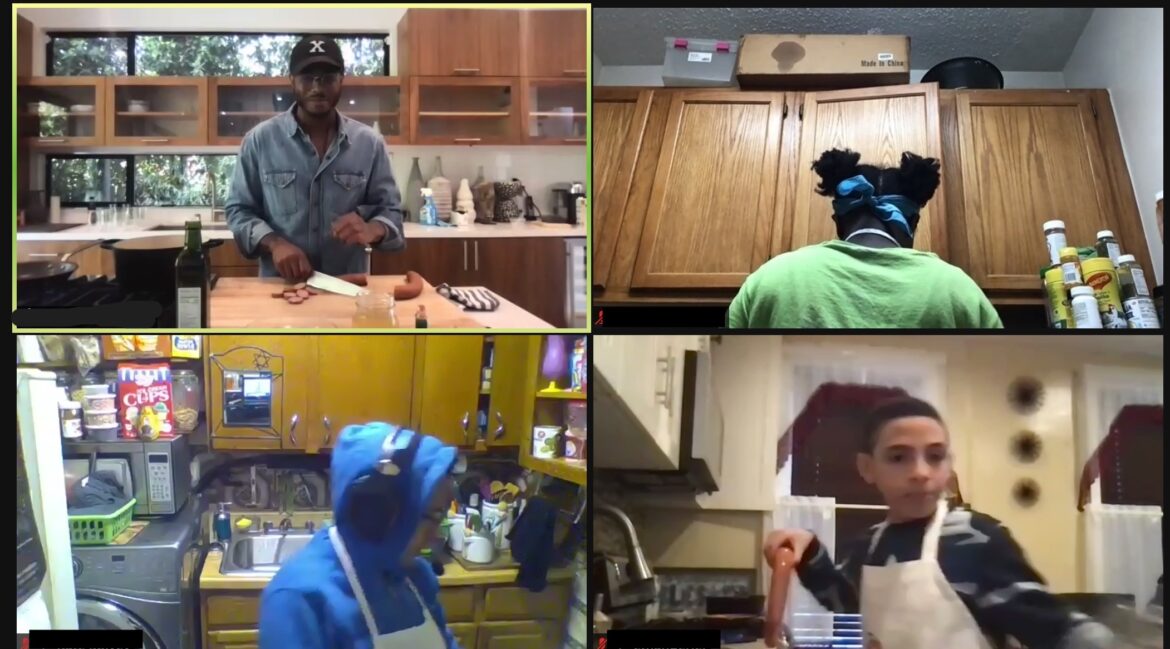SNACC Improves Food Literacy and Food Security for Students in South Bronx
Part of the Food Policy Snapshot Series
Policy name: SNACC (Sustainable Nutrition and Community Connection)
Overview: SNACC is a weekly after-school youth-development program that provides food to students and families in need and teaches middle- and high-school students to prepare healthy meals to enjoy with their families.
Location: South Bronx, New York
Population Served: Eleven students currently participate in the program. Including families, this amounts to approximately 60 individuals served each week.
Food policy category: Food security, nutrition
Program goals: To increase independence and self-sufficiency among youth, to teach youth how to make healthy choices and cook healthy meals, and to increase food security.
How it works: At the beginning of the school year, students in eighth grade can apply to the program. SNACC looks for youth who have an interest in learning, engaging with peers and chefs, and who are open-minded to trying new foods and learning new skills. After the first year, students are invited back to hold leadership roles and help younger students for additional years while still engaging in the weekly cooking sessions.
When students begin the program, they receive a kitchen supply starter kit including items such as an apron, cutting boards, oven mitts, can openers, pots, and pans. Each week, groceries are delivered to the students’ homes, including all ingredients needed to prepare a meal while receiving a live virtual lesson conducted by volunteer chefs. Sessions are held via Zoom every Tuesday from 6:00 to 7:30pm throughout the school year. The meals include at least four portions, so that students can share their dinners with their families, and sessions focus on a different culture, cuisine, and/or cooking technique each week.
A program created by Faces in Between, a New York City-based community outreach nonprofit organization, SNACC is funded by donations that allow it to run at no cost to the students.
Progress to date: SNACC began in January 2020 as a six-month pilot program at a Title I school on the Lower East Side of Manhattan. In the fall of 2020, as a result of COVID-19, the program became virtual and shifted focus to the South Bronx, an area of New York City that was affected most severely by the pandemic.
Why it is important: The Bronx, particularly the South Bronx, is characterized by great socio-economic adversity. SNACC serves students in Congressional District 15, where 34 percent of all individuals live below the poverty line, compared to 12.3 percent nationwide. More than 50 percent of households in the South Bronx receive SNAP (Supplemental Nutrition Assistance Program) benefits, compared to 21 percent citywide, and the Bronx Times reports that the South Bronx experiences the highest rate of food insecurity in the country.
SNACC not only provides South Bronx families with groceries and meals to help with food security, but it also enables youth to gain the skills needed to make healthier food choices and prepare nutritious meals for themselves and their families.
Program/Policy initiated: SNACC was launched in January 2020.
Point of contact:
Danielle Levin, Executive Director
Email: danielle.levin@snaccprogram.org
Similar practices: SNACC is unique in that it is completely virtual, deliveries are made direct to the students’ homes, and it involves the entire family.
Evaluation: A survey conducted at the end of 2021 found that:
- 82% of students reported they had started helping out more often in the kitchen
- 82% of students reported they learned how to eat healthier through the SNACC program
- 90% of SNACC parents reported that their child was more confident and capable in the kitchen
- 90% of families reported that the SNACC meals helped reduce stress around putting food on the table
- 100% of students reported that the food they prepared was used and eaten by both themselves and their families.
Learn more:
- Adolescents’ Cooking Skills Strongly Predict Future Nutritional Well-Being (Science Daily)
- COVID-19 Exposes Food Insecurities in the Bronx (BronxNet)
- Recent Trends and Impact of COVID-19 in the Bronx (Office of the New York State Comptroller)
- Senior Secondary School Food Literacy Education: Importance, Challenges, and Ways of Improving (Nutrients)
References:
- 2021 Annual Report (SNACC Program)
- Bronx Families Face Greatest Barriers to ‘Well-Being’ Across New York’s Counties, Report Finds (City Limits)
- The Bronx has Nearly Twice as Many COVID-19 Cases and Hospitalizations as Manhattan. These Charts Reveal Why. (Business Insider)
- Congressional District 15, NY (Census Reporter)
- Food Pantries, Turkey Drives Becoming Essential for Hungry Families in South Bronx (Bronx Times)
- A Foodscape of The South Bronx (NYC Food Policy Center)
- SNACC (SNACC Program)
- Year in Review 2019 (Faces In Between)


